Related Research Articles
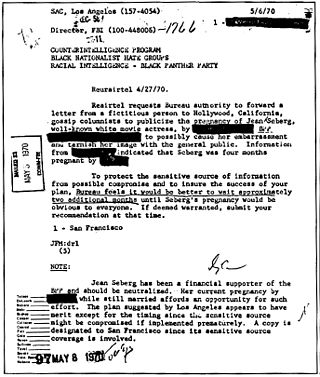
COINTELPRO was a series of covert and illegal projects actively conducted by the United States Federal Bureau of Investigation (FBI) aimed at surveilling, infiltrating, discrediting, and disrupting domestic American political organizations. FBI records show COINTELPRO resources targeted groups and individuals the FBI deemed subversive, including feminist organizations, the Communist Party USA, anti–Vietnam War organizers, activists of the civil rights and Black power movements, environmentalist and animal rights organizations, the American Indian Movement (AIM), Chicano and Mexican-American groups like the Brown Berets and the United Farm Workers, independence movements, a variety of organizations that were part of the broader New Left, and white supremacist groups such as the Ku Klux Klan and the far-right group National States' Rights Party.

Richard McGarrah Helms was an American government official and diplomat who served as Director of Central Intelligence (DCI) from 1966 to 1973. Helms began intelligence work with the Office of Strategic Services during World War II. Following the 1947 creation of the Central Intelligence Agency (CIA), he rose in its ranks during the presidencies of Truman, Eisenhower and Kennedy. Helms then was DCI under Presidents Johnson and Nixon, yielding to James R. Schlesinger in early 1973.

Seymour Myron "Sy" Hersh is an American investigative journalist and political writer. He gained recognition in 1969 for exposing the My Lai massacre and its cover-up during the Vietnam War, for which he received the 1970 Pulitzer Prize for International Reporting. During the 1970s, Hersh covered the Watergate scandal for The New York Times, also reporting on the secret U.S. bombing of Cambodia and the CIA's program of domestic spying. In 2004, he detailed the U.S. military's torture and abuse of prisoners at Abu Ghraib in Iraq for The New Yorker. Hersh has won a record five George Polk Awards, and two National Magazine Awards. He is the author of 11 books, including The Price of Power: Kissinger in the Nixon White House (1983), an account of the career of Henry Kissinger which won the National Book Critics Circle Award.

The director of central intelligence (DCI) was the head of the American Central Intelligence Agency from 1946 to 2005, acting as the principal intelligence advisor to the president of the United States and the United States National Security Council, as well as the coordinator of intelligence activities among and between the various US intelligence agencies.
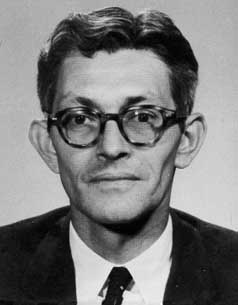
James Jesus Angleton was chief of counterintelligence for the Central Intelligence Agency (CIA) from 1954 to 1975. His official position within the organization was Associate Deputy Director of Operations for Counterintelligence (ADDOCI). Angleton was significantly involved in the US response to the purported KGB defectors Anatoliy Golitsyn and Yuri Nosenko. Angleton later became convinced the CIA harbored a high-ranking mole, and engaged in an intensive search. Whether this was a highly destructive witch hunt or appropriate caution vindicated by later moles remains a subject of intense historical debate.
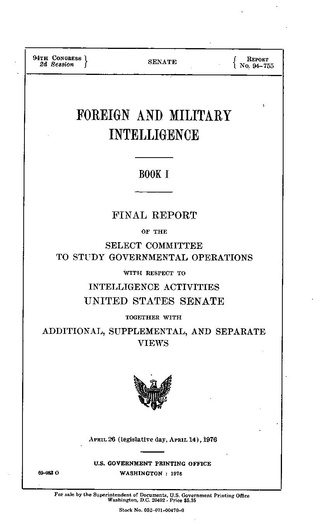
The Church Committee was a US Senate select committee in 1975 that investigated abuses by the Central Intelligence Agency (CIA), National Security Agency (NSA), Federal Bureau of Investigation (FBI), and the Internal Revenue Service (IRS). Chaired by Idaho Senator Frank Church (D-ID), the committee was part of a series of investigations into intelligence abuses in 1975, dubbed the "Year of Intelligence", including its House counterpart, the Pike Committee, and the presidential Rockefeller Commission. The committee's efforts led to the establishment of the permanent US Senate Select Committee on Intelligence.

The United States President's Commission on CIA Activities within the United States was ordained by President Gerald Ford in 1975 to investigate the activities of the Central Intelligence Agency and other intelligence agencies within the United States. The Presidential Commission was led by Vice President Nelson Rockefeller, from whom it gained the nickname the Rockefeller Commission.
The Huston Plan was a 43-page report and outline of proposed security operations put together by White House aide Tom Charles Huston in 1970. It came to light during the 1973 Watergate hearings headed by Senator Sam Ervin.

Project MINARET was a domestic espionage project operated by the National Security Agency (NSA), which, after intercepting electronic communications that contained the names of predesignated US citizens, passed them to other government law enforcement and intelligence organizations. Intercepted messages were disseminated to the FBI, CIA, Secret Service, Bureau of Narcotics and Dangerous Drugs (BNDD), and the Department of Defense. The project was a sister project to Project SHAMROCK.
Project RESISTANCE was a domestic espionage operation coordinated under the Domestic Operations Division of the CIA. Its purpose was to collect background information on groups around the U.S. that the CIA thought posed threats to their facilities and personnel.
Project MERRIMAC was a domestic espionage operation coordinated under the Office of Security of the CIA. It involved information gathering procedures via infiltration and surveillance on Washington-based anti-war groups that might pose potential threats to the CIA. However, the type of data gathered also included general information on the infrastructure of targeted communities. Project MERRIMAC and its twin program, Project RESISTANCE were both coordinated by the CIA Office of Security. In addition, the twin projects were branch operations that relayed civilian information to their parent program, Operation CHAOS. The Assassination Archives and Research Center believes that Project MERRIMAC began in February 1967.

The Central Intelligence Agency, known informally as theAgency and historically as thecompany, is a civilian foreign intelligence service of the federal government of the United States, officially tasked with gathering, processing, and analyzing national security information from around the world, primarily through the use of human intelligence (HUMINT) and conducting covert action. As a principal member of the United States Intelligence Community (IC), the CIA reports to the Director of National Intelligence and is primarily focused on providing intelligence for the President and Cabinet of the United States. Following the dissolution of the Office of Strategic Services (OSS) at the end of World War II, President Harry S. Truman created the Central Intelligence Group under the direction of a Director of Central Intelligence by presidential directive on January 22, 1946, and this group was transformed into the Central Intelligence Agency by implementation of the National Security Act of 1947.
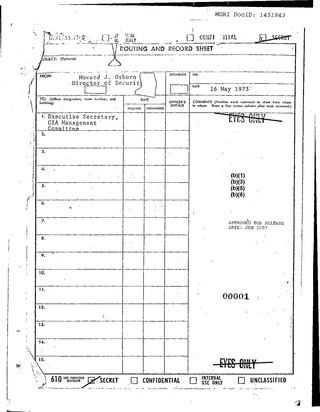
The "Family Jewels" is the name of a set of reports detailing illegal, inappropriate and otherwise sensitive activities conducted by the Central Intelligence Agency from 1959 to 1973. William Colby, the CIA director who received the reports, dubbed them the "skeletons in the CIA's closet". Most of the documents were released on June 25, 2007, after more than three decades of secrecy. The non-governmental National Security Archive filed a request for the documents under the Freedom of Information Act fifteen years before their release.
Project Mockingbird was a wiretapping operation initiated by United States President John F. Kennedy to identify the sources of government leaks by eavesdropping on the communications of journalists.
Executive oversight of United States covert operations has been carried out by a series of sub-committees of the National Security Council (NSC).

The Company is a political fiction roman à clef novel written by John Ehrlichman, a former close aide to President Richard Nixon and a figure in the Watergate scandal, first published in 1976 by Simon & Schuster. The title is an insider nickname for the Central Intelligence Agency. The plot is loosely based on events leading up to the Watergate coverup, centered on Nixon administration attempts to cover up its own illegal activity and that of the CIA dating back to the Kennedy administration. Although all characters are fictional, most are based on real-life political figures, and journalists such as columnist Jack Anderson.

The Intelligence Authorization Act was implemented in order to codify covert, clandestine operations and defines requirements for reporting such operations to the Congress. The American Constitution states, in Article 1, Section 9, that "a regular Statement and Account of the Receipts and Expenditures of all public Money shall be published from time to time." The act was passed along with the Intelligence Oversight Act of 1980, which allowed Congress and members of the agency to be included in important decisions and operations carried out by the Central Intelligence Agency. The Intelligence Authorization Act was also an attempt to limit the authority and secrecy within the Central Intelligence Agency (CIA) regarding foreign and domestic affairs, though its applications extends to each of the intelligence agencies, not just to the CIA.

The Central Intelligence Agency (CIA) is a civilian foreign intelligence service of the United States federal government, tasked with gathering, processing, and analyzing national security information from around the world.
At various times since the creation of the Central Intelligence Agency, the Federal government of the United States has produced comprehensive reports on CIA actions that marked historical watersheds in how CIA went about trying to fulfill its vague charter purposes from 1947. These reports were the result of internal or presidential studies, external investigations by congressional committees or other arms of the Federal government of the United States, or even the simple releases and declassification of large quantities of documents by the CIA.
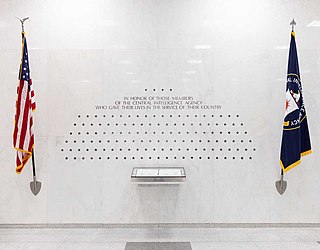
The United States Central Intelligence Agency (CIA) dates from September 18, 1947, when President Harry S. Truman signed the National Security Act of 1947 into law. A major impetus that has been cited over the years for the creation of the CIA was the unforeseen attack on Pearl Harbor, but whatever Pearl Harbor's role, at the close of World War II government circles identified a need for a group to coordinate government intelligence efforts, and the Federal Bureau of Investigation (FBI), the State Department, the War Department, and even the Post Office were all jockeying for that new power.
References
- 1 2 3 4 5 6 Athan Theoharis, Richard H. (2006). The Central Intelligence Agency: Security Under Scrutiny. Greenwood Publishing Group. pp. 49, 175, 195, 203, 322. ISBN 0-313-33282-7.
- 1 2 3 4 Napoli, Russell P. (2005). Intelligence Identities Protection Act and Its Interpretation. Nova Publishers. pp. 18–20. ISBN 1-59454-685-1.
- 1 2 3 4 Friedman, John S. (2005). The Secret Histories: Hidden Truths That Challenged the Past and Changed the World. Macmillan. pp. 278–279. ISBN 0-312-42517-1.
- 1 2 Lyon, Verne. "Domestic Surveillance: The History of Operation CHAOS." Covert Action Information Bulletin , No. 34, Summer 1990, pp. 59-62. Full issue available.
- 1 2 Goldstein, Robert Justin (2001). Political Repression in Modern America: From 1870 to 1976. University of Illinois Press. p. 456. ISBN 0-252-06964-1.
- ↑ Loftus, John; Mark Aarons (April 15, 1997). The Secret War Against the Jews: How Western Espionage Betrayed The Jewish People . St. Martin's Griffin. p. 322. ISBN 0-312-15648-0.
- ↑ Turner, Stansfield. Burn Before Reading. Hyperion, 2005, p. 118. ISBN 9780786867820.
- 1 2 Hixson, Walter L. (2000). Military Aspects of the Vietnam Conflict. Taylor & Francis. p. 282. ISBN 0-8153-3534-2.
- ↑ Seymour Hersh (December 22, 1974). "Huge CIA Operation Reported in US Against Antiwar Forces, Other Dissidents in Nixon Years". New York Times : 1.

